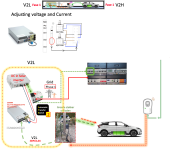Yeah, the MPPT want's to get the best power transfer from what it assumes is a string of solar panels. It's really not the right equipment for this job. Interesting that you got it to work at all though. It may be possible to patch the inverter's solar charge firmware to take a fixed power from the solar input.
I assume that the efficiency is fairy poor, as the car's DC gets converted to AC (in the V2L part of the EVCC), that gets converted to DC in the power supply, and that gets converted to AC in the hybrid inverter. So that's DC → AC → DC → AC. Ideally of course it all happens in one conversion stage instead of three, but then the firmware in the EVCC needs to be even smarter, and there are all sorts of regulatory hassles since the EVCC would be connected to the grid.
You should not need that if you have the right hybrid inverter. It should know to drop the relay to the AC input when the grid goes away, and that's better than relying on you to be there to switch the AT over. Meanwhile your loads on the "essential AC" port of the hybrid inverter should continue to be powered.
Thank you for your reaction.
I have a little luck with the fact that I also have a old Omnik 2500 TL inverter. This inverter does the job without any software change. It is working well and gives a stability power wattage.
With the two potmeters (current and voltage) I can change the output I wish.
And yes...there are hybrid inverters but than you need to know whit hone works OK in this setup.
In my case I was searching for a as cheap as possible solution that works safe and do the job.
I don't want to wait any longer for a solution of the manufactures EV cars and finding and buying a new hybrid solar inverter that works.
I have to deal with the fact that I have a MG4 luxury(trophy) now with a 2.2 kW V2L inverter that gives a AC output. I also don't want to change any hardware on the car that will give any risk of warranty issues etc.
So I use existing and proven technology with a low investment and a easy way of installation.
It is not aloud but it is even possible to put a normal powerful to the output of the solar inverter that make it possible to use a normal power wall outlet at every place in your home.
I took the safest way to use the proven hardware and made a Type2 wall outlet so my wife knows what she do.
A white Type2 plug of the Zappi for Loading and a green type2 for powering our home.
There is only ONE type2 plug that is plugged in the MG4 - without any resisters between the CP etc. It is straight wired to the type2 outlet.
The MG4 senses if the Zappi (loading) or V2L plug is connected.
When the Zappi is plugged in it is easy and everything works automatically. In a normal situation I use only the eco+ charging so the Zappi charge only the extra, not used, solar power into the car.
In the V2L - V2H situation You need to let the MG4 know that you want to extract power of the "power bank on wheels". So in this situation you always needs to do a extra handeling to a give manual command to the MG4. That is for me no problem.
The loss of efficiency ??
@Coulomb asked.
That is not much. When I read the input a meter it is about 600 watt. The output to the grid is about 575 watt. With that figures I can live because the sun is free and I have to pay sometimes for delivering back to the GRID.
My investment is about € 650,- I know that the TCO maybe is not right but I am happy with that.
I also have with this solution a backup power when the Grid will shutdown. A ATS will sense when this happens and switch the Solar inverter to the output of the V2L power supply.


